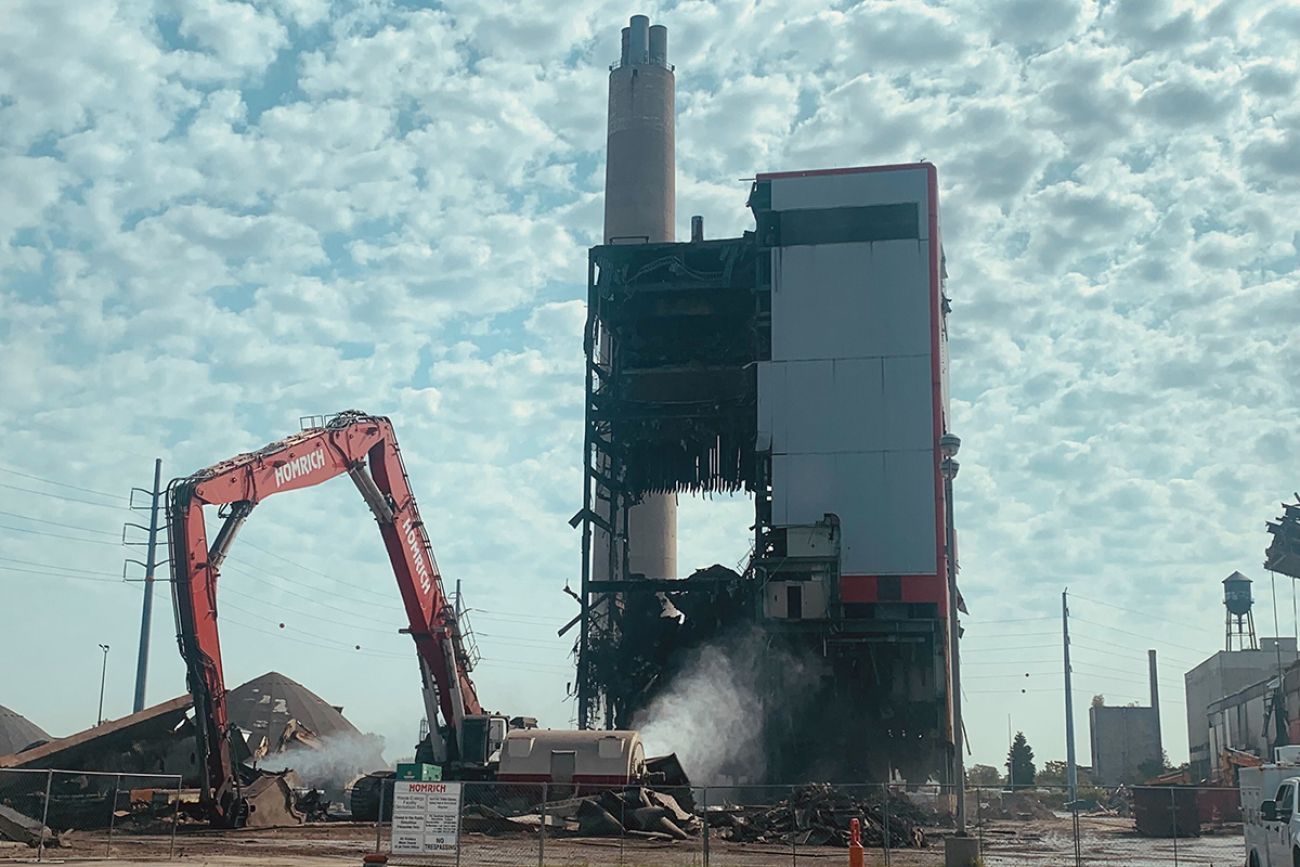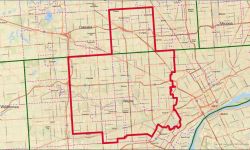Planned implosion of Detroit’s incinerator has neighboring residents concerned


At dawn on Sunday, June 11, the smokestack of Detroit’s incinerator will finally come tumbling down.
But what should be a joyous occasion for the residents who fought for years to get the Detroit Renewable Power incinerator closed has raised new fears.
Neighbors say they’ve not been properly informed about the demolition process, and want assurances that their health won’t be impacted by potentially contaminated dust and debris from the implosion, while city officials say they’ve done adequate outreach.
Related:
- Duggan urges state Legislature to fix Detroit’s ‘unfair’ tax system
- Detroit’s Belle Isle Park now has fast charging stations for EVs
- Detroit recycling rates double, but barriers remain
Joshua Roberson, the District 5 manager for the city’s Department of Neighborhoods, sent community leaders an email on the evening of May 26, notifying them about the planned demolition of the smokestack at 5:15 a.m. on June 11. In the notice, the city advised residents to close their windows and avoid going outside during the time of the demolition. Per the letter, Homrich Wrecking and Dykon Explosive Demolition will be leading the demolition.
With the pending implosion just days away, community leaders feel the city hasn’t given them enough time to ensure every neighbor is informed, nor enough information to protect their health and assuage their fears that the demolition won’t go wrong, like the recent implosion of a smokestack in Chicago that left a mostly Mexican neighborhood blanketed in dust.
KT Andresky, a nearby resident and organizer for Breathe Free Detroit, which led the fight to get the incinerator shut down, said there isn’t enough time to properly ensure residents’ safety.
“Many residents here do not have internet access and will need fliers for direct notification,” Andresky said in an email. “It is such an injustice and bad communication that I fear the whole demolition will be a hack job.”
The situation has Andresky pleading with law advocates at the Great Lakes Environmental Law Center for their help once again. Along with Breathe Free Detroit, the Great Lakes Environmental Law Center co-published a report on the incinerator, finding that it had more than 750 air permit violations. In 2019, the center announced it would file a lawsuit over the violations. The incinerator was shut down just a few months later.
Air pollution experts agree there’s reason to be concerned, and say the city should be doing a better job of informing neighbors about the demolition process and how to protect themselves.
“We have every reason to be concerned about any dust that’s coming off of it,” said Jeff Gearhart, an air quality expert and research director at the nonprofit Ecology Center.
“It is a situation where it’s extremely difficult to in any way decontaminate the structure prior to demolition,” he said. “Any fugitive emissions from the demolition are going to be a mixture of dust that can be contaminated with the products of the materials that were handled and combusted at the site over all these years,” he said, like metals and dioxins.
Detroit’s incinerator, located at 5700 Russell St., was one of the largest municipal incinerators in the country. It began operating in 1986, burning 5,000 tons of trash a day and releasing pollutants like nitrogen oxide, sulfur dioxide, carbon monoxide, and lead into the air and soil of the majority-Black Poletown East neighborhood for decades. Activists finally succeeded in getting it shuttered in 2019. Research shows that ash from incinerators pollute the air, soil, vegetation, and water, and poses a threat to human health.
Life in the incinerator’s shadow was miserable; intense odors often forced neighbors to avoid going outside and keep their windows closed. It also likely contributed to the high asthma rates in the neighborhood – neighboring residents are five times more likely to have asthma than other Michiganders, according to the Ecology Center.
One concern residents surrounding the incinerator have about the demolition is how it will affect their gardens.
Last year, the city tested the soil near the incinerator. After reviewing the results, Gearhart submitted a March letter to Mayor Mike Duggan’s office saying that the Ecology Center found the sampling of the site inadequate and requested action to further investigate “chemicals of concern” detected at high levels and to test for dioxins and per- and poly-fluoroalkylpolyfluoroalkyl substances (PFAS)
Gearhart said he has not received a response from the city.
Tyrone Clifton, director of the Detroit Building Authority, said the city has abated all potential hazardous materials, and that the only things left to remove is concrete.

“We took thorough precautions to assess the site with a remediation study, survey, and a review with a third party to ensure. Our project team has experienced implosion and explosion contractors and engineers who have all done this before. This was a very important criteria in the awarding of the contract beforehand,” Clifton said.
City officials also argue they’ve done adequate outreach.
“We have taken all the necessary steps to notify everyone that will be affected within the impact zone of the demolition,” Roberson said in a statement. He said since April city staff have reached out to community leaders about the tentative demolition date in June, and as of last week have gone door-to-door to talk with residents.
Andresky said the city provided her group with 65 copies of the notice to demolish to distribute, noting that there are more than 200 residents living in the neighborhood. She said she got her paper flier from the city Thursday, June 1. Her neighbor Tommy Pemberton said he still hasn’t gotten the flier as of Friday morning.
“I didn’t receive any notice and I live on the next block,” he said.
Gunn said he was out doing yard work when he saw city officials stop by to drop off a flier at Andresky’s house and a few others.
“I don’t think it was much of an effort so much as it was to appease her [Andresky],” said Gunn, adding that he doesn’t think most residents in the neighborhood are aware of the scheduled demolition.
Gunn said he’s worried about his house that his grandmother first bought in 1965, his garden, and for his grandkids that visit.
Another concern with the demolition of the smokestack Sunday will be the air temperature, Gearhart said, as many Detroiters don’t have air conditioning and aren’t in a position to completely shut their windows for an extended period of time on a hot day. Temperatures Sunday are expected to reach a high of 81 degrees, following a weekend of 90+ degrees.
Gearhart said the Ecology Center has monitors around the incinerator already and will be able to measure any changes in air quality during the demolition and after.
Another potential impact the city is monitoring for is vibrational damage to homes from the demolition, but Clifton said this is unlikely.
The Michigan Department of Environment, Great Lakes, and Energy (EGLE) regulates air pollution and fugitive dust for the City of Detroit, but the department said the demolition is mostly in the city’s wheelhouse.
“EGLE has determined there is no asbestos in the Detroit Renewable Power stack,” said EGLE spokesperson Hugh McDiarmid in a statement, adding EGLE has asked for a detailed fugitive dust plan from the contractors in charge of demolition.
McDiarmid said EGLE’s air quality division has no plans to be on site during the implosion.
“But we are providing any resources the city needs and will be following closely,” the statement said.
Roberson’s email asked community leaders to compile residents’ questions about the demolition and is expected to answer them Wednesday, June 7, at the next East Ferry Warren Community Association meeting.
“At the outset, I think certainly the public notice is leaving a lot to be desired from the city,” said Nicholas Leonard, executive director of the Great Lakes Environmental Law Center.
“You get one chance to do it right, and if it’s done poorly, it can have a really negative impact on public health, the people living around that facility, which would be a terrible way to end what’s otherwise been a really positive story.”
See what new members are saying about why they donated to Bridge Michigan:
- “In order for this information to be accurate and unbiased it must be underwritten by its readers, not by special interests.” - Larry S.
- “Not many other media sources report on the topics Bridge does.” - Susan B.
- “Your journalism is outstanding and rare these days.” - Mark S.
If you want to ensure the future of nonpartisan, nonprofit Michigan journalism, please become a member today. You, too, will be asked why you donated and maybe we'll feature your quote next time!


